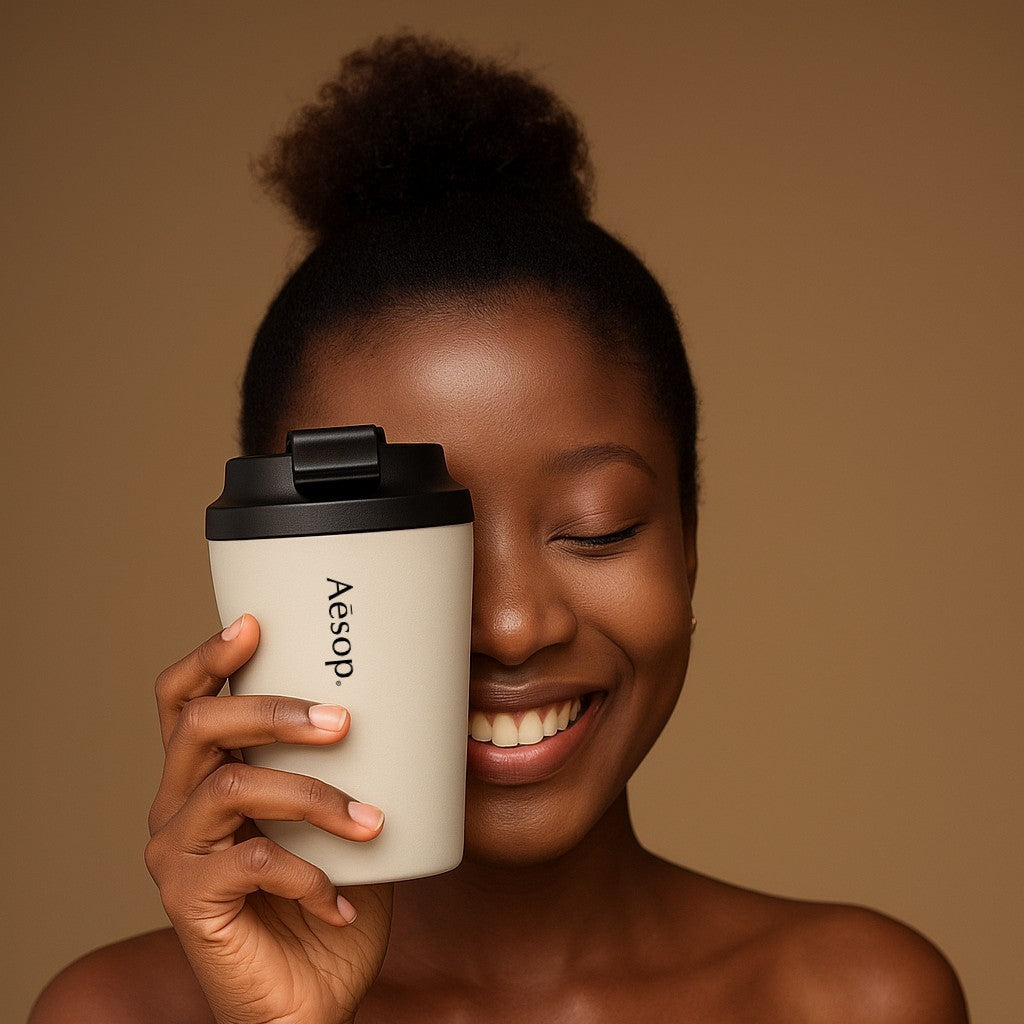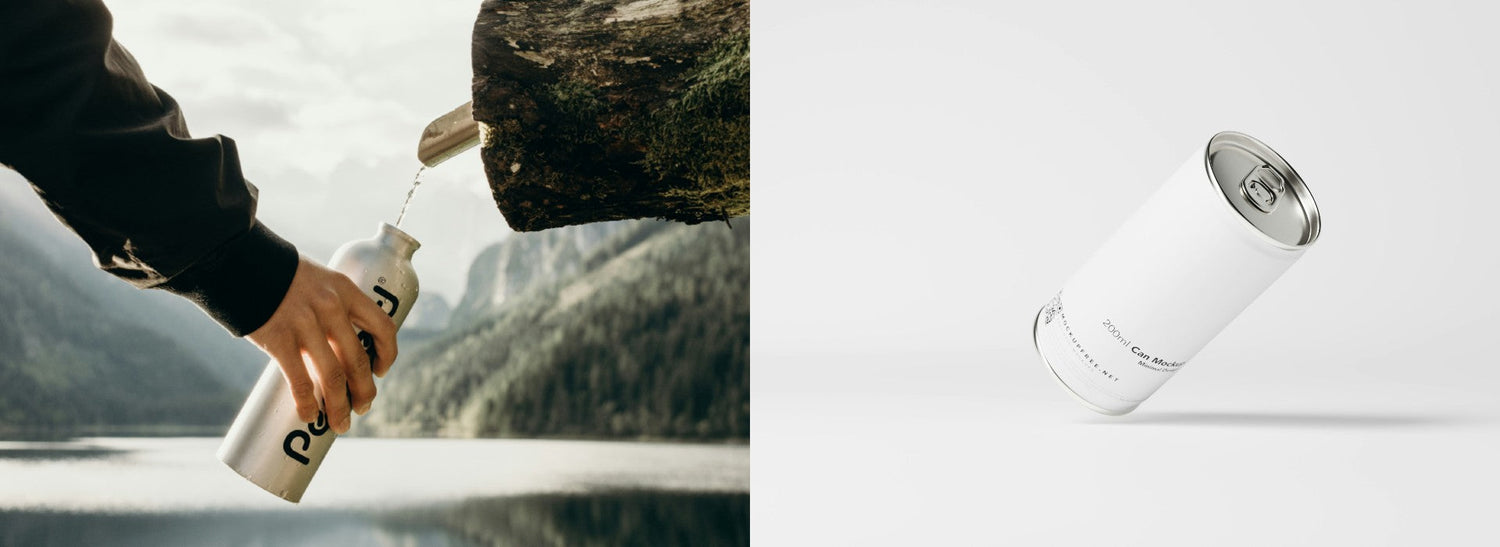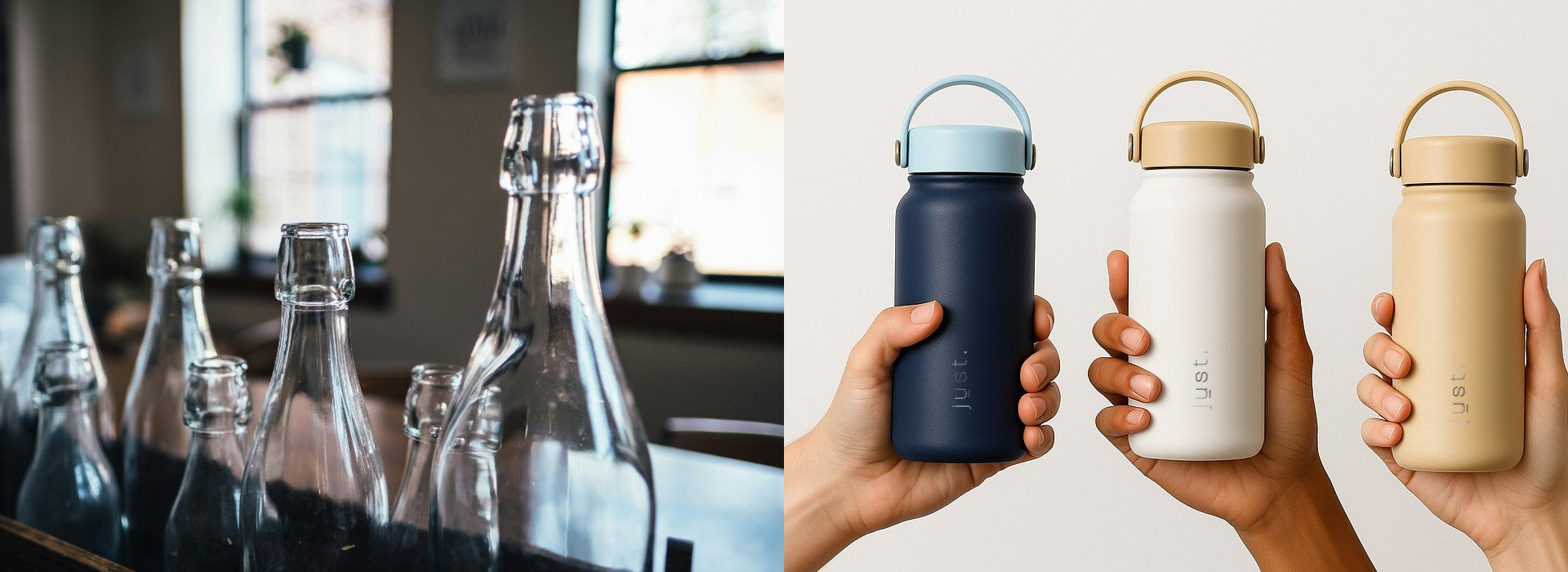When you choose a reusable bottle or bottle of water, the material it's made from should play a crucial role in your decision.
While aluminum water bottles have gained popularity over the years due to their lightweight nature and perceived affordability, they are definitely not be the best choice for long-term use.
Table of contents
Health implications of aluminium water bottles
Why aluminium bottles need a plastic inner lining
Aluminium for single use canned water
Stainless steel v aluminium bottles
At Just Bottle, our business is to make the best water bottles on the market, so we've done our research into the benefits and drawbacks to different water bottle materials and have chosen to use stainless steel for our reusable water bottles.
One option we considered was aluminium, but quickly moved away from the idea, in this article we will explore the reasons why.
Are there health implications with aluminium?
One of the main concerns with aluminum water bottles is the potential health risks they pose. Studies have indicated that prolonged exposure to aluminium might be linked to several health issues, we decided that any link to health issues is unacceptable for a reusable product, even if the jury is still out. Here's the potential health concerns we found:
- Alzheimer's Disease: Some research suggests a connection between high levels of aluminium and the development of Alzheimer's disease. While the evidence is not conclusive, it's a risk many are unwilling to take, especially for a reusable water bottle that is used in everyday life.
- Bone Diseases: Excessive aluminium intake can lead to bone diseases, as it can interfere with the absorption of phosphorus and calcium in the body.
- Neurological Effects: High levels of aluminium have been associated with neurological issues, affecting memory, concentration, and coordination. Again, there isn't any conclusive evidence that using aluminium water bottles are directly linked to the neurological effects, but it's best to urge on the side of caution when choosing your metal water bottle.
When you pick up an aluminum water bottle, you might think you're making a purely metal choice for your daily water intake.
However, there's a little-known fact about these bottles that might surprise you: to overcome these potential health issues, manufacturers that choose to make their reusable bottles from aluminium will usually add a plastic lining to the inside of the water bottle.
But why is this lining necessary, and what does it mean for users? Let's delve into the details.
Why aluminium bottles need a plastic lining
The main reason manufacturers add a plastic lining inside aluminium water bottles is to prevent direct contact between the beverage and the aluminium material. This serves a few essential purposes:
Health Concerns: As touched upon earlier in the article, there are potential health risks associated with consuming drinks that have been in direct contact with aluminium. The plastic lining acts as a barrier, reducing the risk of any aluminium leaching into the cold drinks.
Taste and Smell: Aluminium can react with certain beverages, especially acidic ones, altering the taste and odour. If you've ever experienced a strange kind of "metallic" taste, that's the liquid reacting with the drink inside. The plastic lining ensures that your drink tastes as it should, if you ever have this strange taste it means the plastic lining has failed.
Rust Prevention: Aluminium, though relatively corrosion-resistant, can corrode when exposed to certain substances. The lining helps protect the aluminium from potential corrosion, especially from acidic beverages like fruit juices or sports drinks.
Drinking from a rusty bottle is seriously bad for your health, that's why at Just Bottle, we use stainless steel instead of aluminium for our water bottles.
The lining inside aluminium bottles is typically made from a type of plastic known as resin. This resin is favoured for its ability to form a smooth, protective barrier that adheres well to the aluminium's inner surface.
Potential concerns with the plastic lining
While the plastic lining addresses some of the issues with aluminium, it introduces its own set of concerns:
- BPA and Other Chemicals: I'm sure you've heard the term BPA before and it stand for a chemical called Bisphenol A. This chemical is used in some plastics that can leach into beverages and pose health risks. While many manufacturers have moved away from using BPA in their linings, it's essential to ensure that any aluminium bottle you purchase that is labeled "BPA-free" might be talking about the lid type and not the plastic lining inside the bottle.
- Environmental Impact: While aluminium itself is recyclable, the plastic lining complicates the recycling process. The presence of this lining means that the bottle can't be recycled as pure aluminium, which can impact its recyclability for future use.
- Durability: Over time, especially with frequent use and cleaning, the plastic lining can degrade, crack, or peel. This not only exposes the beverage to the aluminium but can also lead to bits of plastic ending up in your drink.
The erosion of the plastic barrier
This lining, while initially serving as a protective barrier between the beverage and the aluminium, isn't invincible. Over time, it can break down, leaving you unwittingly drinking directly from the aluminium.
The lifespan of the plastic lining
Every product has a lifespan, and the plastic lining inside aluminium bottles is no exception. Several factors can accelerate its degradation:
Heat exposure: Leaving your bottle in a hot car or washing it with very hot water can cause the plastic to weaken or warp.
Acidic beverages: Frequently storing acidic drinks like citrus juices or carbonated sodas can erode the lining faster.
Physical damage: Using abrasive cleaning tools or dropping the bottle might cause micro-tears in the lining.
Chemical cleaners: Using harsh detergents or cleaning agents can deteriorate the plastic over time.
The risks of a compromised lining
Once the lining starts to degrade, several concerns arise:
- Direct Aluminium Contact: The primary purpose of the lining is to prevent the beverage from coming into direct contact with aluminium due to potential health risks and taste alterations. A compromised lining negates this protection
- Ingesting Plastic Particles: As the lining breaks down, tiny plastic particles might mix with the beverage, leading to unintentional ingestion.
- Altered Taste: Without the protective barrier, drinks can acquire a metallic taste, especially if they remain in the bottle for extended periods of time.
How to spot a damaged water bottle lining
If you do choose to purchase an aluminium reusable water bottle, to ensure you're not unknowingly drinking from a compromised bottle, regularly inspect your aluminium bottle:
- Visual Inspection: Look for any discolouration, rust, peeling, or bubbling of the lining.
- Tactile Check: Run your fingers along the inside of the bottle. If it feels uneven or rough in places, the lining might be deteriorating.
- Taste Test: If your water or beverage tastes metallic or "off" suddenly, it might be a sign that the lining is no longer intact.
While aluminium water bottles with their protective plastic lining offer a solution to potential aluminium exposure, it's crucial to remember that this barrier isn't permanent.
Regular checks and proper care can extend the life of your bottle, but being aware of the potential risks ensures you make informed choices about when it might be time to replace your trusty bottle.
It's essential to be aware of the hidden layer inside and its implications. As consumers, understanding the products we use daily is crucial.
When choosing a water bottle, consider all the materials involved, not just the outer shell, to make an informed decision that aligns with your health and environmental values.
Canned water: aluminum in single use bottled water
Canned water is a single use bottle of water that uses an aluminum can instead of plastic. It's become more popular recently with brands like Jason Momoa water using single use aluminum water bottles.
The main benefit is to eliminate single use plastic bottles, which is great, but are there any drawbacks when it comes to single use aluminum? Let's delve into the advantages and limitations of using aluminum in canned water.
Benefits of aluminum in canned water:
- Recyclability: Aluminum is one of the most recyclable materials on the planet. It can be recycled indefinitely without losing its quality, making it a sustainable choice for packaging. Recycled aluminum requires significantly less energy to process than virgin aluminum, reducing its environmental footprint.
- Reduced waste: Opting for aluminum cans over plastic bottles helps mitigate the plastic pollution crisis. Aluminum cans are lightweight and easily recyclable, diverting waste from landfills and oceans. By choosing canned water, consumers contribute to a circular economy where materials are reused and repurposed.
- Preserving freshness: Aluminum offers excellent protection against light, air, and contaminants, ensuring the freshness and purity of the water inside the can. This preservation quality makes canned water a reliable choice for long-term storage and distribution.
- Portability and convenience: Aluminum cans are lightweight, durable, and easily transportable, making them ideal for on-the-go hydration. Whether hiking, camping, or commuting, canned water provides a convenient and sustainable alternative to single-use plastic bottles.
Drawbacks of aluminum in canned Water:
- Energy intensive production: While aluminum is highly recyclable, its initial production requires significant energy inputs. The extraction of bauxite ore, the primary source of aluminum, and the refining process contribute to greenhouse gas emissions and environmental impact.
- Resource depletion: Bauxite mining, the primary source of aluminum, can lead to habitat destruction, deforestation, and soil erosion. While recycled aluminum reduces the demand for virgin materials, the extraction of bauxite still poses environmental challenges in regions where it occurs.
- Lining concerns: As mentioned earlier, aluminum cans are lined with epoxy resin to prevent the metal from reacting with the contents.
While these linings ensure the safety and quality of the water, concerns have been raised about potential health risks associated with certain types of epoxy coatings.
Overall for canned water, our opinion is aluminium is a better choice than plastic. Cutting down on plastic bottles of water is always a great thing to do and the epoxy lining will not break down to expose you to the aluminium compared to a reusable aluminum bottle.
Keep in mind though, as we explored earlier, for reusable water bottles that are designed for long term use, choose stainless steel over aluminum.
Where did the idea of using aluminium drink bottles come from?
Aluminium, the third most abundant element on Earth, has a long history within our culinary and food storage practices. Let's journey through time to understand how this metal transitioned from being a rare item to a staple in our kitchens.
Ancient times: While pure aluminium was not used in ancient times, its compounds were known to early civilisations. The ancient Greeks and Romans used alum, a compound of aluminium, as an astringent and for dyeing purposes.
Early 19th century: Aluminium was first identified as an element in the early 1800s. However, the process of extracting it from its ore was so expensive and labor-intensive that aluminium was more valuable than gold or silver.
It was considered a precious metal, and its rarity made it a symbol of luxury. Napoleon III of France is said to have held a banquet where the most honoured guests were given aluminium utensils, while the others had to make do with gold.
Late 19th century: The late 1800s saw a revolution in aluminium production. The development of the Hall-Héroult process made it possible to extract aluminium from its ore on a large scale, drastically reducing its cost. This democratisation of aluminium production paved the way for its widespread use.
20th century: With mass production, aluminium found its way into various industries, including the food sector.
Cookware: Aluminium's excellent heat conductivity made it a favourite for pots, pans, and other cookware. Its lightweight nature also added to its appeal.
Packaging: Aluminium's malleability allowed it to be rolled into thin sheets, leading to the invention of aluminium foil in the early 20th century. Foil became a popular choice for wrapping food, protecting it from light, oxygen, and contaminants.
Cans: The mid-20th century saw the rise of aluminium cans for cold beverages. They were lighter than their steel counterparts and resistant to corrosion, making them a great option for single use fizzy drinks.
Food additives: Aluminium compounds even made their way directly into what we eat through baking powders, colourings, and anti-caking agents.
Modern times: As aluminium's use in food products grew, so did concerns about its potential health effects. Studies began to explore the link between aluminium exposure and health issues like Alzheimer's disease, though conclusive evidence remains under debate.
These concerns led to a less use of aluminium in direct contact with food and a push for more transparent labelling to improve consumer awareness.
From its humble beginnings as a precious metal to its everyday use in modern kitchens, aluminium's journey is a testament to human ingenuity and adaptability.
As we continue to use aluminum in daily life, it's essential to stay informed about its benefits and potential risks.
Final thoughts: Are aluminium bottles safe?
At Just Bottle, we believe your water bottle should be safe, long-lasting, and kind to the planet. These three values - safety, durability, and sustainability guide every product we create.
So, are aluminium bottles safe?
Aluminium on its own isn’t ideal for drinking bottles. It’s a soft, reactive metal, which means it can affect the taste of your water and potentially leach harmful substances, especially if the protective lining inside gets scratched or wears down.
That’s why aluminium bottles always need a plastic or epoxy lining, and those linings can raise health concerns over time.
That’s why we choose stainless steel - it’s naturally safe, doesn’t need a lining, and won’t affect the taste of your drink. It’s also much stronger than aluminium, meaning it won’t dent or break easily and will last for years.
Plus, stainless steel is one of the most sustainable materials out there, it can be recycled forever without losing quality.
If you’re looking for a wide-mouth bottle that keeps your water cold for hours, our stainless steel bottles are the better, safer choice. You're not just picking a water bottle, you're choosing something better for your health, better for the environment, and better for the future.
FAQ's
Are aluminium water bottles safe to use long-term?
Aluminium water bottles often require a plastic lining to prevent health risks and taste changes. Over time, this lining can degrade, raising concerns about direct aluminium contact and plastic particles in your drink.
Why do aluminium bottles have plastic linings?
Plastic linings in aluminium bottles protect against metal leaching, off-tastes, and corrosion. However, they can break down with heat, acidic drinks, or wear and tear, leading to potential health and durability issues.
What’s the difference between aluminium and stainless steel bottles?
Stainless steel bottles are naturally safe, don’t need a plastic lining, and last longer. Aluminium bottles are lighter but require linings and can dent easily. Stainless steel is more durable and better for daily use.
Is canned water in aluminium bottles safe?
Yes, for single-use. Canned water uses an epoxy lining that doesn't break down like in reusable aluminium bottles. It’s a good alternative to plastic bottles, but for reusable options, stainless steel is the safer choice.




